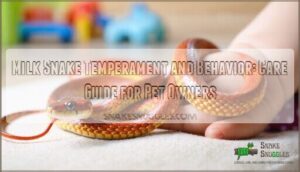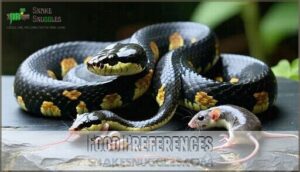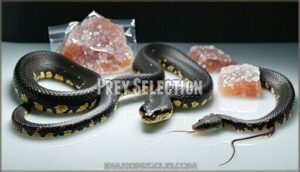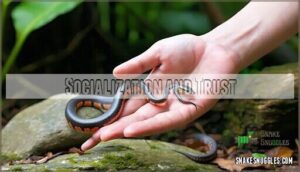This site is supported by our readers. We may earn a commission, at no cost to you, if you purchase through links.

These docile constrictors rarely bite and adapt quickly to regular handling, making them perfect beginner pets.
Young milk snakes can be nippy, but they settle into calm, manageable companions with consistent interaction.
They’re naturally curious and tolerate handling well when approached respectfully.
Unlike many snake species, milk snakes don’t typically exhibit aggressive behaviors and respond positively to gentle care.
Their forgiving nature means handling mistakes won’t traumatize them.
Understanding their specific needs for temperature, humidity, and feeding schedules helps maintain their naturally peaceful disposition throughout their lives.
Table Of Contents
Key Takeaways
- You’ll get a calm, docile companion – Milk snakes are naturally gentle creatures that rarely bite and adapt well to regular handling, making them perfect for beginners.
- Consistent handling builds trust – Start with brief 5-minute sessions and gradually increase the duration as your snake becomes comfortable with your touch and presence.
- Proper environment affects temperament – Maintain temperatures between 75-90°F with 50% humidity, provide hiding spots, and use appropriate substrates to keep your snake stress-free.
- They’re forgiving pets – Unlike aggressive species, milk snakes tolerate handling mistakes well and respond positively to gentle care throughout their 12-15 year lifespan.
Milk Snake Temperament
You’ll find that milk snakes are naturally docile creatures, making them excellent pets for both beginners and experienced reptile keepers.
Their calm temperament develops further with regular, gentle handling and proper environmental conditions that promote trust and reduce stress behaviors, making them even more excellent pets.
Docile Nature
Despite their intimidating appearance, milk snakes are naturally docile creatures that rarely show aggression.
Their calm temperament stems from generations of selective breeding and natural docility origins. Subspecies differences exist – Honduran and Nelson’s varieties are particularly gentle, while black milk snakes may be slightly more temperamental initially.
These nonaggressive snakes adapt well to captivity, with calmness factors including proper environment and gradual socialization through effective taming methods. Thoughtful enclosure design, including proper heating and hides, contributes to their desired mood.
Handling and Interaction
Your gentle approach determines successful snake handling outcomes.
Support the snake’s entire body during interaction, allowing natural crawling motions.
Start with brief five-minute sessions, gradually extending handling duration as trust develops.
Watch for stress signals like hissing or coiling, which indicate immediate return to enclosure.
Use side approach techniques rather than grabbing from above, as this builds trust more effectively.
Regular, positive snake interaction creates well-socialized pets comfortable with human contact.
Black Milk Snakes require high levels of humidity to thrive.
Environmental Factors
Your snake’s environment shapes its personality more than you might expect.
Proper temperature gradients between 75-90°F create comfort zones that reduce stress factors.
Maintaining humidity levels around 50% prevents shedding issues that can cause irritability, while smart substrate choice like aspen shavings supports natural burrowing behaviors.
Quality lighting impact affects circadian rhythms, while habitat enrichment through hiding spots builds confidence.
These snake habitat conditions directly influence how calmly your milk snake handles interaction.
Handling Milk Snakes
You’ll need to handle your milk snake properly to maintain its calm temperament and build trust over time.
Regular, gentle handling sessions help your snake become comfortable with human interaction, though patience is essential since each snake adapts at its own pace.
Approach and Support
When approaching your milk snake, move slowly and deliberately to avoid startling them.
A gentle approach helps establish trust and reduces defensive behaviors like tail rattling.
Always support the snake’s entire body, especially the head and midsection, during handling.
Proper body support prevents stress and injury while building confidence.
Keep initial handling sessions brief, gradually increasing duration as your snake becomes more comfortable with human interaction.
Handling Techniques
Begin with a gentle approach when handling your milk snake – move slowly and support their body weight completely.
Use both hands to distribute pressure evenly along their length, never grabbing just the head or tail.
Start with short session durations of five minutes, gradually increasing as trust builds. Milksnakes are popular pets because of their tolerance of interaction.
These snake handling techniques create a positive snake handling environment that reinforces trust while respecting your snake’s natural temperament and reactions.
Supervising Children
Children require constant supervision during milk snake interactions due to Age Appropriateness and varying milk snake temperament.
Safe Handling techniques become critical when young handlers are involved, and it is essential to educate children about proper snake behavior around children before any interaction begins.
Limit Interaction Duration to prevent stress for both parties, as this is crucial for a safe and enjoyable experience.
Though Bite Risk remains minimal with proper Child Education, supervision guarantees snake handling supervision guidelines are followed consistently.
Enclosure Design
Creating the right enclosure setup directly impacts your milk snake’s temperament and overall well-being.
You’ll need to balance proper sizing, heating, lighting, and substrate choices to create an environment that promotes calm, trusting behavior in your pet.
Terrarium Size
Your milk snake’s house needs depend on age.
Hatchlings thrive in 10-gallon tanks, while adults require 40-gallon vivariums or 34-inch enclosures.
Space requirements matter for milk snake behavior – cramped quarters stress snakes.
Adult dimensions should include vertical space for climbing enrichment.
A good rule of thumb is to verify the tank is appropriately sized for your snake.
Snake enclosure size directly impacts milk snake temperament, so don’t skimp on room for a healthy and happy pet, ensuring the right environment.
Heating and Lighting
Your heat source creates the foundation for your milk snake’s wellbeing.
Establish a temperature gradient with a basking area reaching 85-90°F using a basking bulb, while maintaining cool side temperatures between 70-80°F.
Heat mats provide gentle nighttime heat without disturbing sleep cycles.
UVB lighting supports calcium metabolism—install fluorescent lights with UVB rays spanning half the enclosure.
Many owners find UVB products available enhance their snake’s health.
Full spectrum lighting mimics natural conditions, promoting healthy behaviors and proper digestion, which is supported by UVB lighting.
Substrate Options
For ideal milk snake substrate selection, choose materials that balance substrate safety with practical maintenance.
Coarse beech woodchips, Aspen bedding, Repti bark, and cypress shavings provide excellent moisture retention while allowing natural burrowing behaviors.
Paper towels offer cost-effective cleaning frequency advantages for busy owners, and many owners purchase milk snake substrate from online retailers.
Each substrate choice impacts your snake enclosure environment differently—naturalistic substrates create appealing snake vivarium substrate choices but require more frequent replacement than simpler options.
Milk Snake Diet
Your milk snake’s diet directly impacts its temperament and overall health.
Proper nutrition with appropriate prey items and feeding schedules creates a calm, well-adjusted pet that’s easier to handle and less prone to stress-related behaviors.
Food Preferences
Understanding prey size is vital for successful snake feeding.
Your milk snake’s dietary needs center on appropriately sized rodents, typically mice.
Pre-killed frozen mice eliminate injury risks that live prey can pose.
Proper prey size should match your snake’s thickest body section.
This approach guarantees safe swallowing and proper digestion.
Snake diet success depends on matching prey options to your pet’s size and nutritional needs, ensuring a well-planned diet with proper digestion.
Feeding Frequency
Age determines your milk snake’s appetite schedule.
Hatchling feeding occurs every 5-7 days, while adult feeding happens every 10-14 days.
Breeding frequency increases for reproductive females, requiring weekly meals.
Young snakes need consistent nutrition for growth, but adults maintain weight with less frequent feeding.
This natural pattern mirrors their wild metabolism, where seasonal changes affect hunting opportunities.
Prey Selection
Matching prey size to your snake’s girth prevents regurgitation and guarantees proper digestion.
Choose rodents that create a slight bulge when swallowed, typically equaling your snake’s thickest body section.
- Rodent Size: Hatchlings need pinky mice, while adults handle adult mice or small rats based on girth
- Frozen vs. Live: Pre-killed frozen prey eliminates injury risk and parasite transmission concerns
- Nutritional Variety: Occasional quail or chicks provide dietary diversity beyond standard mouse offerings
- Feeding Schedule: Monitor snake feeding response to adjust prey size and snake feeding frequency accordingly
Health and Hygiene
Maintaining proper health and hygiene for your milk snake isn’t just about keeping things clean—it’s essential for preventing serious health issues that can affect your snake’s gentle temperament.
Regular enclosure maintenance, vigilant monitoring for parasites like mites, and consistent health checks will keep your milk snake comfortable and stress-free.
Regular maintenance is crucial for the overall well-being of your milk snake.
Cleaning Enclosures
Proper nutrition sets the foundation for health, but keeping your snake’s home spotless prevents illness and stress. Regular snake enclosure cleaning maintains a healthy environment for your pet.
Establish a consistent cleaning schedule with daily spot-cleaning and monthly deep cleans. Remove waste immediately to prevent bacterial growth and odor control issues. Use reptile-safe disinfectant choices like diluted bleach solutions or commercial reptile cleaners.
You can find a suitable reptile habitat disinfectant online.
| Cleaning Task | Frequency |
|---|---|
| Spot-clean waste | Daily |
| Replace water bowl | Weekly |
| Substrate replacement | Monthly |
| Disinfect surfaces | Monthly |
| Deep clean vivarium | Quarterly |
Proper waste disposal and thorough cleaning prevent mold prevention concerns in humid environments. Focus on corners and hiding spots where moisture accumulates during your snake habitat optimization routine.
Preventing Mite Infestations
Quarantine newcomers for 4-12 weeks using paper towel substrate for easy mite detection.
Regular cleaning disrupts mite life cycles, while freezing substrate below 35°F kills eggs.
Use mite sprays like Provent-A-Mite for 30-day protection.
Sterilize all equipment with bleach or steam.
Schedule veterinary checkups to catch early signs of mite infestations before they spread throughout your snake enclosure.
Monitoring Health
Regular health monitoring helps catch problems early in your milk snake.
Watch for shedding problems like stuck shed, respiratory issues such as mouth breathing, and scale rot from excessive moisture.
Check for mites and unusual behavior changes.
Implement quarantine protocols for new snakes.
Schedule annual veterinarian visits for thorough reptile care and parasite prevention to maintain ideal snake health, which includes checking for respiratory issues and ensuring proper care to prevent scale rot.
Socialization and Trust
Building trust with your milk snake requires patience and consistent, gentle handling sessions that gradually increase in duration.
You’ll need to recognize their body language cues and respect when they prefer privacy, especially as older snakes may become more selective about interaction, which involves understanding their body language.
Building Trust
Trust develops through consistent interaction and gentle handling techniques that allow your milk snake to recognize your scent and presence.
Start with brief sessions, moving slowly to avoid startling responses, and use positive reinforcement through calm, supportive contact to help establish familiarity.
Allow your snake to acclimate to your touch gradually, building confidence through repeated, patient encounters that demonstrate safety and predictability in your interactions.
Recognizing Cues
Understanding snake behavior starts with observing stress signals and body language cues.
Rapid, jerky movements indicate anxiety, while slow, fluid motions show relaxation.
Tail vibration signals defensive responses, and musking reveals fear.
Tongue flicking demonstrates curiosity, not aggression.
Behavioral changes like prolonged hiding or escape attempts suggest discomfort.
Environmental cues affect handling response substantially, which can be influenced by recognizing defensive responses.
Providing Privacy
Older milk snakes need more downtime than younger ones, so respect their need for solitude.
Secure hides and visual barriers in your enclosure create safe spaces where your snake can retreat.
Schedule handling breaks between sessions to prevent stress buildup.
These natural behaviors help maintain healthy snake temperament and reduce anxiety in your pet’s environment.
Creating these conditions is part of creating snake friendly spaces for reptiles.
Milk Snake Care Tips
Creating the right environment for your milk snake goes beyond just meeting basic needs—it directly impacts their calm temperament and overall well-being.
You’ll need to maintain specific humidity levels, provide proper furnishings, and establish a regular maintenance routine to keep your snake healthy and content.
Humidity and Temperature
Maintaining proper temperature and humidity creates a comfortable environment for your milk snake.
You’ll need to establish an ideal gradient between 90°F on the warm side and 75-80°F on the cool side.
Night temperatures should drop to around 80°F for natural cycling.
Temperature monitoring helps you track these requirements accurately:
- Install thermometers on both warm and cool sides of the vivarium
- Use a basking spot reaching 90°F for thermoregulation
- Maintain humidity at 40-60%, increasing to 70-80% during shedding periods
Shedding humidity becomes particularly important when your snake’s skin appears cloudy or blue-tinged, requiring careful attention to humidity levels.
Furnishings and Hides
Your milk snakes need proper enclosure enrichment to thrive. Provide two hiding spots—one on each temperature side—using commercial hides or overturned containers.
Add climbing branches for exercise and exploration. Choose substrate safety by avoiding cedar or pine shavings.
Place a water bowl large enough for soaking on the cool side. Hide variety keeps your snake mentally stimulated and secure. Provide proper enclosure enrichment and ensure substrate safety to support overall well-being.
Regular Maintenance
Daily care routines keep your milk snake healthy and comfortable.
Enclosure upkeep involves spot-cleaning waste removal immediately and replacing milk snake substrate monthly.
Water renewal should occur weekly or when soiled.
During shedding support periods, increase humidity by misting lightly.
Regular equipment checks guarantee proper snake temperature requirements and humidity levels maintain ideal ranges.
Monitor your snake’s behavior during routine maintenance to assess overall health and environmental satisfaction.
Proper UVB lighting helps prevent metabolic bone disease.
This is crucial for maintaining your milk snake’s overall well-being.
Frequently Asked Questions (FAQs)
What is the personality of a milk snake?
Like a gentle giant wearing a warning costume, you’ll find milk snakes are surprisingly docile and calm companions.
They’re naturally peaceful, becoming more trusting with regular handling, making them excellent beginner-friendly pets.
What is the calmest milk snake?
Honduran milk snakes are considered the calmest subspecies, with their docile nature making them excellent for beginners. You’ll find they handle well and rarely show aggression once acclimated.
Do milk snakes bite humans frequently?
Unlike medieval knights who rarely faced serpents, you’ll find milk snakes don’t bite humans frequently.
They’re generally docile creatures that prefer fleeing over fighting.
While hatchlings might be nippy initially, regular gentle handling builds trust and reduces defensive behaviors substantially. They’re generally
Can milk snakes live with other snakes?
Milk snakes shouldn’t live with other snakes.
They’re naturally cannibalistic and will eat smaller snakes, including their own species.
You’ll need separate enclosures for each snake to prevent predation and guarantee their safety.
What sounds do milk snakes make?
Silence isn’t always golden when you’re dealing with milk snakes! You’ll hear hissing when they’re threatened, defensive tail rattling that mimics rattlesnakes, and occasional soft breathing sounds during normal activity.
How long do milk snakes live?
You’ll find a typical lifespan of 12-15 years, though some can reach 21-22 years in captivity.
They reach maturity within three or four years, providing a long-term commitment for pet owners.
Are milk snakes active during daytime?
Dawn breaks with hope—you’re wondering if these nocturnal hunters are actually daytime creatures.
Milk snakes are nocturnal, staying active at night and resting during the day.
They only venture out during cooler, wet days.
Conclusion
Observe, learn, and adapt—these steps help you understand milk snake temperament and behavior.
By providing a stable environment, consistent handling, and proper care, you’ll support your snake’s gentle nature.
Remember to monitor temperature, humidity, and feeding schedules for peak health.
Handle your milk snake with respect, use safe techniques, and supervise children during interactions.
With patience and attention to detail, you’ll guarantee your milk snake remains a calm, rewarding companion for years to come.
- https://www.xyzreptiles.com/milk-snake-care/
- https://www.reddit.com/r/snakes/comments/1b64hey/whats_the_truth_about_milk_snakes/
- https://www.petco.com/content/content-hub/home/articlePages/caresheets/milk-snake.html
- https://www.livescience.com/53333-milk-snakes.html
- https://portal.ct.gov/-/media/DEEP/wildlife/pdf_files/outreach/fact_sheets/milksnakepdf.pdf
















